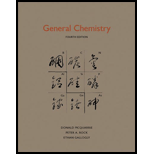
Concept explainers
Interpretation:
The surface energy required to change a spherical drop of water of
Concept Introduction:
A molecule inside liquid feels attraction from all directions uniformly, but surface molecules only feel force from inward direction. So, surface molecules of a liquid feel a net inward force and therefore tends to minimize their surface area to minimize the number of molecules on the liquid surface. This inward force is surface tension.
Higher the attractive force on molecules, higher will be the surface tension of liquid. The surface tension of a liquid holds the liquid droplet in spherical shape because a sphere has the lowest surface area. For a spherical drop, high surface tension in necessity.
Answer to Problem 15.27P
The surface energy needed to change a spherical drop of water of
Explanation of Solution
The diameter of bigger sphere is
The radius of bigger sphere is calculated as follows:
The formula for surface area of sphere is as follows:
Here,
Substitute
The formula to calculate the surface energy of bigger sphere is as follows:
Substitute
The formula to determine volume of bigger sphere is as follows:
Substitute
The bigger sphere is divided into 2 smaller spheres of equal size so the volume of both smaller spheres will be same. Consider volume of smaller sphere be
Rearrange equation (4) to calculate
Substitute
Rearrange equation (3) to calculate radius of smaller sphere.
Substitute
Substitute
Substitute
So the difference in surface energy of smaller and bigger sphere is calculated as follows:
So the surface energy needed to change a spherical drop of water of
Want to see more full solutions like this?
Chapter 15 Solutions
General Chemistry
 ChemistryChemistryISBN:9781305957404Author:Steven S. Zumdahl, Susan A. Zumdahl, Donald J. DeCostePublisher:Cengage Learning
ChemistryChemistryISBN:9781305957404Author:Steven S. Zumdahl, Susan A. Zumdahl, Donald J. DeCostePublisher:Cengage Learning ChemistryChemistryISBN:9781259911156Author:Raymond Chang Dr., Jason Overby ProfessorPublisher:McGraw-Hill Education
ChemistryChemistryISBN:9781259911156Author:Raymond Chang Dr., Jason Overby ProfessorPublisher:McGraw-Hill Education Principles of Instrumental AnalysisChemistryISBN:9781305577213Author:Douglas A. Skoog, F. James Holler, Stanley R. CrouchPublisher:Cengage Learning
Principles of Instrumental AnalysisChemistryISBN:9781305577213Author:Douglas A. Skoog, F. James Holler, Stanley R. CrouchPublisher:Cengage Learning Organic ChemistryChemistryISBN:9780078021558Author:Janice Gorzynski Smith Dr.Publisher:McGraw-Hill Education
Organic ChemistryChemistryISBN:9780078021558Author:Janice Gorzynski Smith Dr.Publisher:McGraw-Hill Education Chemistry: Principles and ReactionsChemistryISBN:9781305079373Author:William L. Masterton, Cecile N. HurleyPublisher:Cengage Learning
Chemistry: Principles and ReactionsChemistryISBN:9781305079373Author:William L. Masterton, Cecile N. HurleyPublisher:Cengage Learning Elementary Principles of Chemical Processes, Bind...ChemistryISBN:9781118431221Author:Richard M. Felder, Ronald W. Rousseau, Lisa G. BullardPublisher:WILEY
Elementary Principles of Chemical Processes, Bind...ChemistryISBN:9781118431221Author:Richard M. Felder, Ronald W. Rousseau, Lisa G. BullardPublisher:WILEY





